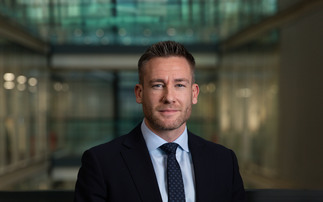
In July, Professional Pensions assembled a panel of experts to look at how schemes can balance social outcomes, financial return and liquidity in fixed income investments.
The roundtable - chaired by PP editor Jonathan Stapleton and held in association with Columbia Threadneedle Investments - also discussed the launch of a global version of Columbia Threadneedle Investments' UK Social Bond Fund, looking at how this new strategy can help schemes achieve their ESG aims globally.
Ben, can you give us some background to this new strategy and talk us through how your global social bond fund will work in practice? How can investors create positive social outcomes from global fixed income investing?
Benjamin Kelly: In 2014, Columbia Threadneedle and Big Issue Invest devised the concept of a corporate bond fund that is designed to produce positive social outcomes across the UK and, at the same time, provide a corporate bond-like return. We started by focusing on eight areas of social outcome - providing investment to fund social housing, education, access to services in the community, healthcare and infrastructure, and also to help the transition to renewable energy.
We launched a European version of this in 2017, and just a few weeks ago we launched the global version of this in an open-ended investment company structure.
Essentially, they are all trying to do the same thing - it is all about how you can enable the bond market to generate positive social outcomes or impacts. It is very well positioned to do so because the bond market is the largest asset class, at roughly $13trn (£10.2trn) - and in many cases those organisations doing the most impactful work are not able to issue equity, such as development banks, agencies and charities.
We have also seen huge growth in the specific use of proceeds bonds, whereby the proceeds are ringfenced. Green, social and sustainability bonds are good examples of these.
We have seen the growth of the green, social, and sustainability market over the last six years, and Covid-19 has been a great accelerator of this trend. I have been championing social factors for several years, but a lot of people just focus on the environmental side. The social part has been the poor relation for years, but Covid-19 allowed people to see social from a different perspective.
We have now seen $3.5bn of green, social and sustainability bonds issued, which is quite an increase from 2017, when it was just about $1bn - indeed, after the pandemic, the conversation switched from whether to issue a green bond to how to issue the right type of green, social or sustainability bond.
How are you seeing this develop on the institutional side?
James Edwards: There is a lot being written in the press about pension schemes not allocating capital to productive assets. Three years ago you would probably agree that if I came to you with a green bond mandate, a scheme's fiduciary duty would trump any ESG concerns. But we have moved far beyond that now - this is a nice way of complementing existing credit allocations without giving up the kinds of returns that you still need to tick your fiduciary duty box.
Do you have specific questions for Ben and James following their introductory comments?
Mark Hedges: How much of this is new, real social improvement? How much is just activity that these businesses, agencies and governments would have done anyway with their existing funding?
Benjamin Kelly: You get a mixture of issuers. Some are just recycling - so we have to spend a lot of time looking at this. It is why we have an in-depth process. Proceed bonds are very transparent - if you take a green gilt that was issued a couple of years ago, the proceeds are, essentially, supporting infrastructure projects in the UK.
But how would you know that the government would not do that anyway? That is a fair point and they probably would devote some of their capital to these sort of projects. However, what you are trying to achieve with these kinds of bonds is the complete look-through - if the issuer is not issuing a green bond, they can, essentially, spend that money however they want. With a green bond, whatever you say you are going to invest in at the time of issuance, you have to invest in that, and you can track that.
David Bennett-Rees: What yield over gilts are you expecting?
Benjamin Kelly: If we take our UK fund at the moment, it is yielding 6.2%.
Mark Hedges: What duration is that?
Benjamin Kelly: It is 3.8 years. It is not designed to significantly outperform a credit-like benchmark. It is supposed to provide what you would expect with a normal corporate mandate but with the benefit of positive social outcomes.
David Bennett-Rees: Does that premium stay as they travel along?
Benjamin Kelly: So far, we have seen that they do.
David Bennett-Rees: What is the default rate like on these sort of social bonds?
Benjamin Kelly: They are investment grade and we have never had a default on any of them.

Alan, what are your thoughts with regards to this?
Alan Pickering: I am slightly more positive on this, particularly from a defined contribution (DC) trustee perspective. In defined benefit (DB) land, the employer really has to be comfortable with what is being done in their name, because the pension scheme has their name on it. When it comes to DC land, I have a much more direct relationship with the member and, while I don't want to be philanthropic on behalf of the members or turn an auto-enrolment vehicle into the pension equivalent of a venture capital trust, I can see a place for this asset class.
I cannot speak about this product specifically, but this asset class would fit really well on an annual infographic to members showing them what we are doing with their money and that we are trying to use their funds positively.
There is a place for this sort of fund, particularly as we move into a world of transition. As long as we are not being philanthropic or cutting-edge with members' money, if we can put on the infographic that we have helped spread community banking or new education opportunities for workers who are displaced because of changing technology, there is a good story here to tell members. Hopefully, by doing that, they would have greater confidence in what we are doing with the mass of their money, because I want people to be in the default fund, not in the self-select fund. If I can show that we are doing some good stuff in the default fund, they are much more likely to place their trust in everything else that we do on their behalf.
To what extent are you seeing pension schemes ramp up the way they look at the social aspect of investing?
Andrew Cole: ESG has clearly lost its priority status, as trustees have limited bandwidth. It is very important, but perhaps the opportunities from an investment perspective are somewhat limited. It then comes down to the appropriate financial return, as well as showing, like Alan said, our DC members that we are a force for good in the world, which is also important and valuable.
Martin Collins: Generally, across the whole defined benefit space, ESG has fallen off the agenda since the mini budget. It used to be at the top of the agenda, but it got displaced and we are only just starting to come back to it.
Saying this, there has been a lot of research into what makes members engage with pensions, particularly younger members. This work was done in the context of what could persuade them to contribute more, because most just don't contribute enough. The phrase that unlocked member interest and engagement was that their pension fund was a force for good in the world, so I think this approach is very exciting.
Coming back to DB pensions, however, we have found it quite tough - we have tended to find that green tilting of investments is as far as schemes want to go on direct ESG implementation. There is more focus now on challenging existing managers on how they take ESG into account.
Part of this is because the shift of focus in the last year or two has been towards buyouts and preparing for them - we are thinking about liquidity and what we can pass over to an insurer.
James Edwards: In our experience, the majority of risk transfer exercises involve passing over gilts and/or cash to the insurer. For larger schemes, there may be the potential to negotiate the in-specie transfer of some assets, but in most cases the pension scheme will need to move to gilts and cash. The typical duration of ESG bond strategies is shorter dated; relative to a traditional corporate bond buy-and-maintain mandate they are therefore potentially more liquid. Shorter-dated credit that gives you a yield consistent with a buy-and-maintain mandate enables a scheme to stay invested in credit up to the price lock, and then can be realised quickly for cash - the maturity profile of a social bond strategy like this is consistent with those aims.
Bobby Riddaway: Of the three areas of ‘E', ‘S' and ‘G', most people get the climate story but there are still those who do not. But it is something you can really engage people with - it would be very hard to find somebody who does not agree with you doing social good if you can still generate decent returns as well.
But it is not necessarily about having a large allocation generating loads of return, at least not in DC. It is about getting members to engage with the benefits.
My only question would be what is the reinvestment programme? How active are these funds in terms of the money - if you go to DC, you are going to have to be investing for 20, 30 or 40 years.
Benjamin Kelly: The turnover of the fund is higher than a typical corporate bond fund because we have a focus on new issues. If you are going to create impact, you really need to do that at the point of issue. If I go to my desk and buy a bond on the secondary market that might be a social bond but, while it is a social bond, that money has essentially already been spent.
Mark Hedges: One of the key challenges from an investor perspective is how much return are we giving up for this labelling as a social bond? We have seen green bonds being issued because they get a price premium, so issuers can get a lower margin.
Benjamin Kelly: Yes, there have been occasions of that. We calculate around one or two basis points in aggregate - a little tighter than what you would expect from a conventional bond. I would say that when you get ones that are particularly innovative in this area, those do seem to receive quite a lot of demand.
To what extent does the ESG decision come down to your trustee board's statement of investment beliefs? To what extent does this change over time?
Andrew Cole: Every scheme will have its own views on what is socially important for their scheme. And there can be conflicting views within schemes themselves.
Mark Hedges: A board's investment beliefs will always change over time as people get more information and awareness. They will change also as the complexion of the board changes, as different members come on at different times.
David Bennett-Rees: Especially member-nominated trustees.
Mark Hedges: Yes. The responsible investment strategy that forms part of the statement of investment principles (SIP) will be something that evolves constantly. For instance, a big focus within one of my schemes recently has been how we deal with modern slavery issues, an area where we are now in process of contacting every manager.
It will often be idiosyncratic to a particular fund in terms of where they focus their efforts on social and broader ESG factors. We have talked about how ESG has fallen off the agenda, but the focus is returning - a lot of us have our first or second year of TCFD reports to do, so there is a focus there. Alongside that, you have a big push from The Pensions Regulator around the whole diversity, equality and inclusion (DEI) agenda, which encompasses a range of social aspects.
Ben, what is the spectrum of your social bond fund? What are the range of things that you are targeting there? Where can we see what value is being added in terms of its impact on society across the globe?
Benjamin Kelly: We assess all our bonds and score them across nine social factors, out of a total possible 31. It is an evidence-based process, where we get as much information as we can to illustrate the social benefits.
In terms of our hierarchical approach, housing and healthcare sit at the top. As you move down, you go through education, employment, access to the community, what we call ‘social facilitation' - which includes access to infrastructure - and funding the energy transition.
Subject to the financials, we want the most impactful bonds in the fund, so those are the ones that are scoring higher out of 31.
How do you review and monitor a fund's work?
Benjamin Kelly: We use an entity called The Good Economy. The people who founded it were an offshoot of Big Issue Invest, and they will review our investments and opine on how we have rated them, and the panel has an opportunity to make objections. The panel for global is three individuals from The Good Economy, including two independents.
These panels debate the investments that are in fund - discussing new trends and how we can perhaps improve from a social perspective.
Where issuers have come with controversies, we have consulted the views of the committee and taken it forward. We always try to engage where possible - this is not what we would call an exclusionary fund where something happens, and you instantly want to get it out of the portfolio. We want to understand what has happened - if a mistake has happened, what has an entity done to overcome that and to ensure that this is not going to happen again.
If you can provide assurances, maybe it is something that we can keep in the fund. If it is something that we remain uncomfortable with and the issuer has been very lacklustre in trying to provide a solution, then it might be time to part from that particular holding.
Andrew Cole: To what extent are investors involved in the fund for the ‘S' reasons as opposed to the reasons of getting an attractive return for a diversified group of underlying assets?
Benjamin Kelly: Everyone is very keen to know about the social aspect of this fund. They understand this is not a fund that is going to provide stellar outperformance versus a traditional investment grade mandate - they are there because you can get a corporate-like return with all this additional social benefit.
Saying that, our investor base has broadened over time - and we are seeing an increasing number of investors that aren't sustainability specialists taking an interest in the fund.
Ultimately, however, you have to be an investor in the fund for the right reasons - if you just want the investment grade return, maybe this is not necessarily the fund for you, but, if you are interested in getting the social or sustainability impacts as well, this could provide them.
Andrew Cole: People are much more interested in the impact that their money has today and are more willing to give up a certain amount of return in order to create good in the world, whatever ‘good' might mean - whether it is with regards to climate, social factors or better governance.
Alan Pickering: We do, however, have to be careful not to give the impression that ESG destroys value. If ESG is applied intellectually, it ought to add value rather than destroy it. It would be really dangerous if people start to think that they pay a price for being responsible investors.
Andrew Cole: You are right, Alan, but there is a price differential, there is definitely a price differential in the green bond space, and that is due to supply and demand - there is a higher demand for what are perceived to be more attractive assets.
James Edwards: I would argue there is a risk differential as well. Those green bonds typically have a better credit rating or lower risk than the equivalent non-green bonds, so your risk-adjusted return on the green side may be higher as well.
Martin Collins: What is the net cost though? To what extent do green bonds cost more because you are doing more work in terms of validation, which must translate into the fees.
James Edwards: The point we are making is the premium here is not material relative to what you already have in the portfolio - as such, it could serve as a good complement to a traditional corporate bond portfolio that is doing all the things that you want it to and has passed your fiduciary tests. This is just being more explicit about where it is going to invest.
Mark Hedges: It gets you that good news story, that you can sell to members without necessarily being a major part of your portfolio - it can be a small slice of your overall fixed income piece.
Bobby Riddaway: The more we make explicit the ways in which we are using that money for good in the ESG area, the less pressure there will be to do more reporting and more checklists, and the more difference we will make.
Is your key market for this fund DC or are you looking across DB and DC clients?
James Edwards: It's applicable to both. It is still a nascent market, and I agree that it may be more relevant in DC, given the timeframe, and so on. But, as Ben has explained, the risk return characteristics of the asset class do not cost you anything materially and, if a DB fund was looking to add something that is a bit more explicit about outcomes, this strategy could serve as a good complement to traditional corporate credit in the portfolio.
What are your final comments and key takeaways following our discussion?
Andrew Cole: It is interesting there is a product like this in the market. As trustees, we need to think more broadly than we perhaps have traditionally and, for me, this fund is certainly something that I would be interested in if it adds diversification in terms of risk.
One of the first issues when looking at a portfolio is assessing the risk-based returns. When one looks at the positives of this strategy, it is not just about financial returns. As a number of people have said, there are clear benefits that we, as trustees, need to look at and consider in perhaps more depth than we have done, because the ‘S' has been the poor sister when it comes to the ‘ESG' acronym that we all love.
Mark Hedges: I agree - social probably has been the poor relation in ESG but it is seeing increased focus. There are potentially opportunities for pension schemes to invest in things that have a social impact if you can get the right trade-off between risk and return.
Also, as trustees we are increasingly having to evidence what we are doing - we have to deal with TCFD, we have to deal with governance and we have the implementation statement. You can see the next stage is that we are going to have to start evidencing, to some degree, what we are doing with the ‘S' side - it may come through regulation, or it may not if we are proactive in showing how we have an impact.
Investing in something like this, provided we are comfortable with the terms, becomes quite an explicit way of demonstrating that we are having some social impact.
Martin Collins: I would just reflect on what has been said - as we are increasingly investing DB schemes in bonds, it is interesting that this possibly gives us a way to do something about the ‘S', which has often been neglected.
Bobby Riddaway: It is a really interesting fund. If you look at ESG, you are often offered something like equity-tilted funds whose impact is very difficult to quantify. If you are going to go for impact investment, it is usually high-risk venture capital. This sounds like something where it is clear to see the impact that you are having and does not seem to be as costly for the given return. It is certainly something I want to look at a bit more closely, and something that, for schemes, should be a relatively easy move into improving their impact.
Alan Pickering: An individual who influenced my career more than anybody else was a Durham miner who was sacked when the coalmine shut down. The government of the day built a shirt factory for him to go and work in. He said, ‘I would rather go down the working men's club and say that I am an ex-miner than a current employee in a shirt factory' - that really has focused my mind on the importance of transition. As institutional investors, we are ideally placed to help society and the world transition from where we are now to, hopefully, ending up in a better place. Focusing on the ‘S' - repurposing old buildings, communities and workers - will help us play an active role in that transition and give us credibility among young people by saying to them, ‘We are not being philanthropists on your part. We are not taking undue risk is being cutting-edge technology investors. We are helping society manage that transition, and your money is financing that'.
This roundtable was held on 12 July 2023 in association with Columbia Threadneedle Investments







